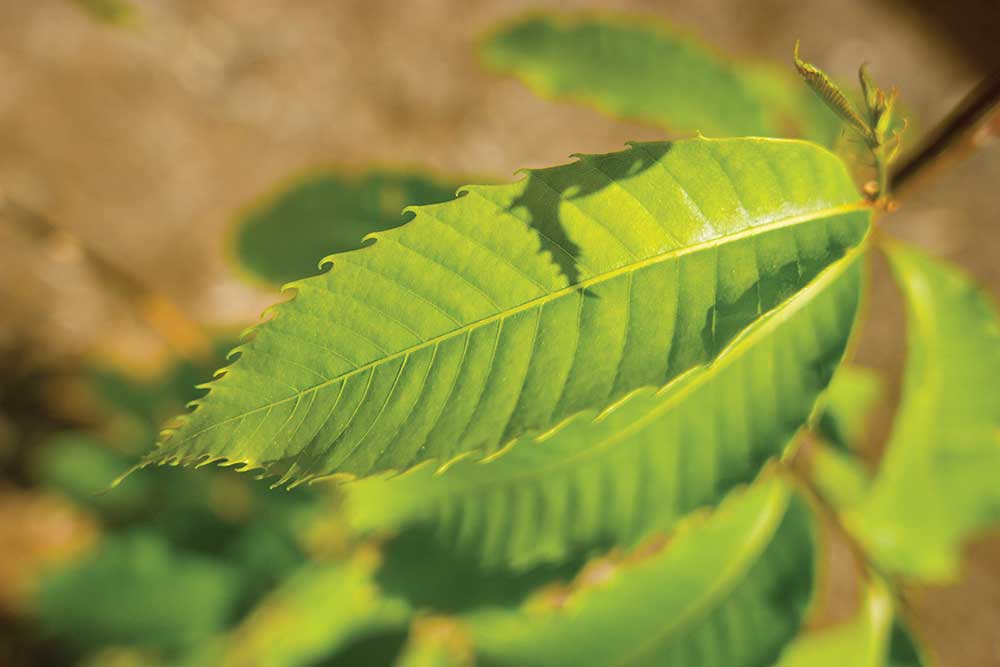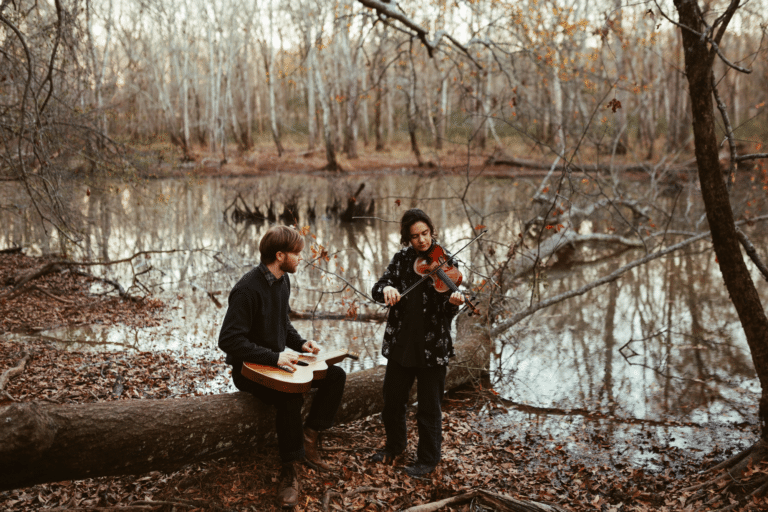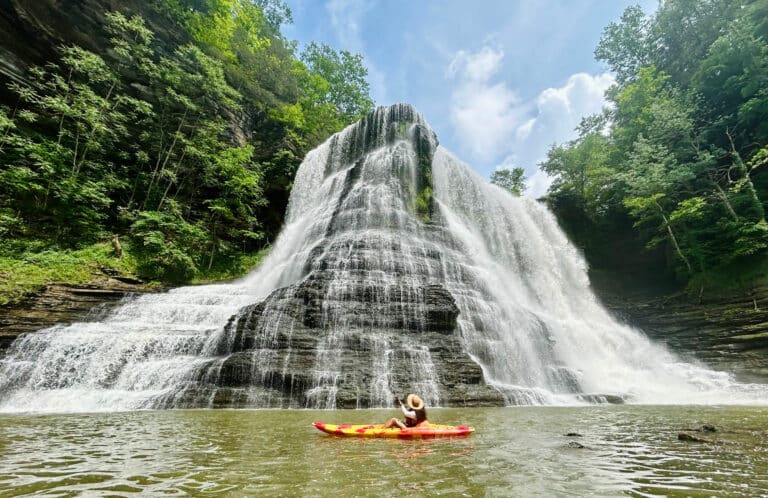A closeup of a leaf on a potentially blight-resistant American chestnut hybrid showing the leaf’s distinctive canoe shape and curved teeth. Photo Courtesy of The American Chestnut Foundation.
Scientists are Restoring Appalachia’s Most Important Tree: The Chestnut.
The small mound of pollen that Paul Sisco pours from a pill vial comes from an American chestnut hybrid that he calls “my lucky tree,” “my trophy,” “my champion.”
At six years old, it is already more than 20 feet tall, with a straight, stout trunk. The bark shows the merest ripple at the point where Sisco tested the tree by injecting it with Cryphonectria Parasitica, also known as chestnut blight.
The blight’s destruction of roughly 4 billion American chestnuts in the early 20th century has been called the country’s greatest ecological disaster. The breeding of Sisco’s star tree at an American Chestnut Foundation orchard south of Asheville may turn out to be a milestone in its reversal.
The hope is that the Hershey Kiss-shaped nuts produced by this crossing will grow into trees with even greater resistance than their parents, and that they will emerge as prime stock for the repopulation of chestnuts in Appalachian forests. It’s a goal Sisco has been pursuing for more than 20 years.
It’s a devotion inspired by the magnificence of the chestnut—so numerous, productive and beautiful that it was sometimes called the “perfect tree”—and by the tragedy of its destruction.
“The chestnut has a great story,” Sisco said.
But this sense of mission also comes from the knowledge that chestnuts are not alone. American forests, said Stacy Clark, a research forester with the U.S. Forest Service, “are under siege from invasive exotoics.” It sometimes seems, she added, that the most spectacular trees—Fraser firs, hemlocks, elms, ashes and dogwoods—are the most vulnerable.
A wild landscape repopulated with cultivated or genetically engineered versions of these species would necessarily be less wild. But if scientists and the public accept this as the price of revival it means the Foundation is not just fighting for American chestnuts but creating a model to fight for American forests.
“If we can show we can save a single species at a time, and that species has a great impact, I think it leads to scientists studying other species seeing that there are feasible solutions out there,” said Ben Jarrett, the Foundation’s Southeast regional science coordinator.
Chestnut blight, a misfortune throughout its range, was a calamity in the southern Appalachians, where the species was a keystone of the ecosystem, culture and economy, Susan Freinkel wrote in her 2007 book, American Chestnut: The Life, Death and Rebirth of the Perfect Tree.
The trees grew largest here—more than a dozen feet wide at the base and ten times that high—and most abundantly. In some swaths of forest, chestnuts accounted for one in every four mature hardwood.
In the fall, they carpeted the woods with starchy, protein-rich nuts that sustained wildlife, livestock and people. One elderly mountain resident told Freinkel that chestnut harvest season was the only time of the year he wasn’t hungry.
Farm families earned much-needed cash gathering nuts for shipment to Eastern cities. They built cabins, coffins, fences and furniture from the tree’s straight-grained, rot-resistant wood. They worked for timber companies that realized so much profit from extracting the tree’s tannic acid that earnings from pulp and timber sales were gravy.
The blight—accidentally imported in Asian chestnut trees—was first identified in a New York City park in 1904, and its devastation of southern forests coincided with the economic collapse of the Great Depression.
“Double whammy,” Jarrett said.
Early restoration efforts ended after several decades of frustration and dwindling public support—but not before scientists developed a few promising strains by crossing American chestnuts with their Chinese counterparts, which are at least partly resistant because they evolved with the blight.
This gave Burnham stock to work with. He advocated a method of breeding called backcrossing that he had used with corn and that has been the driving strategy of the Foundation’s work since its founding in 1983.
The idea: Cross Chinese-American hybrids with successive generations of American chestnuts that still grow wild and that, though doomed to die of blight, sometimes live long enough to produce nuts.
Select the most resistant specimens from each crossing. The result, he predicted, would be trees that look just like American chestnuts—that are just as tall and straight, just as loaded with flowers and nuts—yet are able to fight off blight like their distant Chinese ancestors.
Repeatedly crossing these trees with one another should concentrate resistance, Burnham said, producing a new perfect tree for a permanently infected landscape.
It’s a goal that Sisco, working with trees that are 15/16ths American chestnut, is now closing in on. So are scientists at the Foundation’s national research farm in Meadowview Va., and at orchards run by several of its state chapters, most notably Pennsylvania’s.
“Pennsylvania is by far the farthest along,” Jarrett said.
But another big step remains: producing enough highly resistant trees, with enough genetic diversity, that they can fill seed orchards and interbreed freely.
And then another step: allowing this stock to produce the two or three billion chestnuts needed for it to reclaim its dominant place in Eastern forests.
“It’s a very long-term project,” Sisco said.
U.S. Forest Service has established 13 plots of 15/16ths American chestnuts in National Forests in the South. And though the point of this research is to test conditions for replanting, not to begin reforestation, the performance of these trees has been encouraging, said the Forest Service researcher Clark. In the oldest of these plots, planted in 2009, between 50 and 80 percent of the trees have escaped infection and the tallest are now nearly 40 feet tall.
“The trees are performing very well in terms of height and survival,” Clark said.
Meanwhile, scientists are working on another controversial approach—the creation of a genetically modified American chestnut. The blight works by emitting an acid that kills chestnut tissue, making it easier for the fungus to consume. By borrowing a gene from wheat that neutralizes this acid, Powell and Maynard (who recently retired), have produced a pure-bred American tree as resistant as most Chinese chestnuts.
Although they must still receive approval from three federal agencies, which is expected to take at least two years, they have prepared for the approval process with tests that have so far revealed no potential negative impacts to surrounding trees and no changes to the nuts and flowers.
This has helped satisfy many critics who didn’t like the idea of introducing an engineered tree into forests, Powell said, including some members of the Foundation.
“There’s been some friendly competition with us over the years because we were going on two different tracks and they wanted to make sure their efforts weren’t wasted,” Powell said. “But now they are fully behind it.”
Powell said his work can also be applied to other vulnerable tree species.
The Ozark chinquapin is a relative of the American chestnut, he said, and its restoration is “something we can almost immediately step into.” His team has also made progress on altering elms to resist Dutch elm disease. “We know how to get the gene in the elm,” he said. “All we have to do is pick the right gene.”
Even if researchers do not borrow his team’s methods, Powell said, they can follow the regulatory path that they have created.
This includes a Forest Service scientist in Indiana who is working to develop a genetically modified ash tree with built-in resistance to the emerald ash borer, an invasive insect that has killed millions of trees in the eastern United States.
It also may include researchers at the Forest Restoration Alliance, based in Waynesville, N.C., and modeled after the Chestnut Foundation. This group is seeking resistance to both the balsam wooly adelgid, an insect that wiped out historic stands of mature Fraser firs and continues to plague the Christmas tree industry, and the hemlock wooly adelgid, which has devastated that tree’s population through most of the East.
So far, the Alliance has focused on building breeding stocks from naturally resistant specimens, said the group’s director, Fred Hain, a retired N.C. State University professor. But he has an open mind about genetic modification, he said. “I think it has more potential than just about any approach out there.”
Which is what drives Powell to expand his project’s reach to other species.
“I’m trying to get a center set up for tree restoration,” he said, adding that establishing methods to fight other invasive pests, “is a very big deal to us.”
Sisco, on the other hand, is focused strictly on the chestnut.
“I’m blessed, or cursed, with a one-track mind,” he said, and he is encouraged by the recent successes in chestnut breeding. “After 33 years on this thing,” he said, “it makes me happy that I feel like I didn’t waste my life.”








